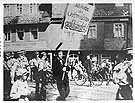
|
|
|

|

|

|

|
|
Click on an image to see a larger, more detailed picture.
|
|
|
|
|
| 1933: The Nazi State Begins |

|
pg. 58 |

|
|
|
|
| |
 Roll call at Oranienburg, Germany, the concentration camp built on the Havel River. Like other camps within Germany before the war, Oranienburg was not as harsh a camp as those that would open during the war. In addition to the standard fatigue duty and drill, prisoners were allowed occasional recreational opportunities. Nevertheless, the regimentation of daily routines and the ever-present armed guards reminded prisoners of their status.
Roll call at Oranienburg, Germany, the concentration camp built on the Havel River. Like other camps within Germany before the war, Oranienburg was not as harsh a camp as those that would open during the war. In addition to the standard fatigue duty and drill, prisoners were allowed occasional recreational opportunities. Nevertheless, the regimentation of daily routines and the ever-present armed guards reminded prisoners of their status.
Photo: National Archives/United States Holocaust Memorial Museum Photo Archive
|
 Three young Polish Jews--Szaja Dershowitz, Meyer Fliegelman, and David Saleschutz--pose aboard the San Marco en route from Trieste, Italy, to Palestine. Increased antisemitism at home coupled with Zionist activism spurred individuals to forsake their troubled native land for promises of a new and better life in the Jewish homeland. While more than 40,000 Polish Jews journeyed to Palestine before 1933, most refugees went to the United States and the urban centers of Western and Central Europe.
Three young Polish Jews--Szaja Dershowitz, Meyer Fliegelman, and David Saleschutz--pose aboard the San Marco en route from Trieste, Italy, to Palestine. Increased antisemitism at home coupled with Zionist activism spurred individuals to forsake their troubled native land for promises of a new and better life in the Jewish homeland. While more than 40,000 Polish Jews journeyed to Palestine before 1933, most refugees went to the United States and the urban centers of Western and Central Europe.
Photo: Norman & Amalia Petranker Salsitz/United States Holocaust Memorial Museum Photo Archive
|
 A German Jew is forced to carry a sign that says he had "ravaged a Christian girl." The public humiliation of Jews was the Nazis' first step to systematically removing them from German society. SA members also cut the beards off Jewish men and forced wealthy Jewish women to scrub the streets with their undergarments.
A German Jew is forced to carry a sign that says he had "ravaged a Christian girl." The public humiliation of Jews was the Nazis' first step to systematically removing them from German society. SA members also cut the beards off Jewish men and forced wealthy Jewish women to scrub the streets with their undergarments.
Photo: Hulton Getty
|
 Joseph Goebbels founded Der Angriff (The Attack) in Berlin in 1926. An official organ of the Nazi Party, the paper cynically incited violence against German Jews. This January 23, 1933, headline states, "The day has come: Berlin belongs to us!"--an exhultant reference to Hitler's imminent ascension to real power in the German government.
Joseph Goebbels founded Der Angriff (The Attack) in Berlin in 1926. An official organ of the Nazi Party, the paper cynically incited violence against German Jews. This January 23, 1933, headline states, "The day has come: Berlin belongs to us!"--an exhultant reference to Hitler's imminent ascension to real power in the German government.
|
|

|

|

|

|
 January 28, 1933: German Chancellor Kurt von Schleicher resigns.
January 28, 1933: German Chancellor Kurt von Schleicher resigns.
|
 January 30, 1933: German President Paul von Hindenburg appoints Hitler chancellor of Germany; Franz von Papen is named vice-chancellor. The Nazis refer to this as Machtergreifung ("Seizure of power").
January 30, 1933: German President Paul von Hindenburg appoints Hitler chancellor of Germany; Franz von Papen is named vice-chancellor. The Nazis refer to this as Machtergreifung ("Seizure of power").
|
 February 2, 1933: Political demonstrations are banned within Germany.
February 2, 1933: Political demonstrations are banned within Germany.
|
 February 12, 1933: "Bloody Sunday" riots in Berlin lead to the death of one Communist and injuries to hundreds of other citizens, including Jews.
February 12, 1933: "Bloody Sunday" riots in Berlin lead to the death of one Communist and injuries to hundreds of other citizens, including Jews.
|
|
|
|
|
| 1933: The Nazi State Begins |

|
pg. 58 |

|
|
The Holocaust Chronicle
© 2009 Publications International, Ltd.
|
|
